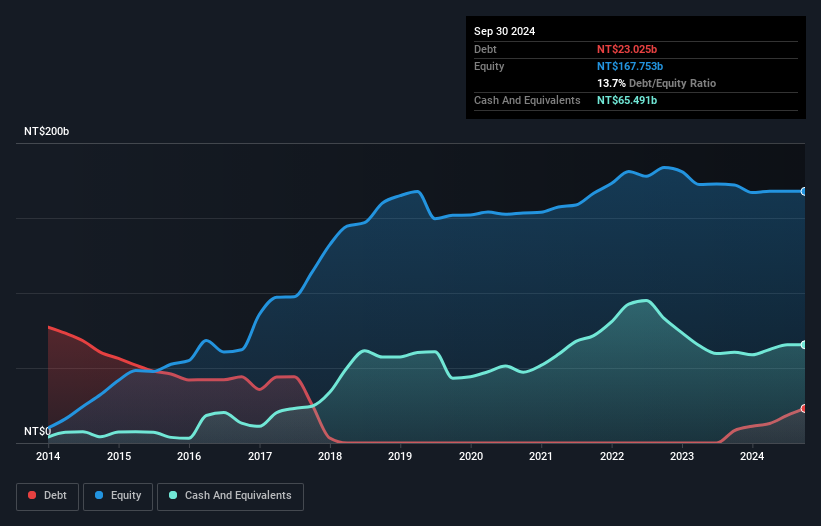David Iben put it well when he said, 'Volatility is not a risk we care about. What we care about is avoiding the permanent loss of capital.' When we think about how risky a company is, we always like to look at its use of debt, since debt overload can lead to ruin. As with many other companies Nanya Technology Corporation (TWSE:2408) makes use of debt. But is this debt a concern to shareholders?
What Risk Does Debt Bring?
Debt assists a business until the business has trouble paying it off, either with new capital or with free cash flow. Part and parcel of capitalism is the process of 'creative destruction' where failed businesses are mercilessly liquidated by their bankers. However, a more common (but still painful) scenario is that it has to raise new equity capital at a low price, thus permanently diluting shareholders. Of course, the upside of debt is that it often represents cheap capital, especially when it replaces dilution in a company with the ability to reinvest at high rates of return. The first step when considering a company's debt levels is to consider its cash and debt together.
Check out our latest analysis for Nanya Technology
What Is Nanya Technology's Debt?
The image below, which you can click on for greater detail, shows that at June 2024 Nanya Technology had debt of NT$23.0b, up from NT$8.30b in one year. But on the other hand it also has NT$65.5b in cash, leading to a NT$42.5b net cash position.

A Look At Nanya Technology's Liabilities
Zooming in on the latest balance sheet data, we can see that Nanya Technology had liabilities of NT$24.0b due within 12 months and liabilities of NT$9.13b due beyond that. On the other hand, it had cash of NT$65.5b and NT$10.2b worth of receivables due within a year. So it can boast NT$42.5b more liquid assets than total liabilities.
This luscious liquidity implies that Nanya Technology's balance sheet is sturdy like a giant sequoia tree. On this view, lenders should feel as safe as the beloved of a black-belt karate master. Simply put, the fact that Nanya Technology has more cash than debt is arguably a good indication that it can manage its debt safely. When analysing debt levels, the balance sheet is the obvious place to start. But it is future earnings, more than anything, that will determine Nanya Technology's ability to maintain a healthy balance sheet going forward. So if you're focused on the future you can check out this free report showing analyst profit forecasts.
In the last year Nanya Technology wasn't profitable at an EBIT level, but managed to grow its revenue by 24%, to NT$36b. Shareholders probably have their fingers crossed that it can grow its way to profits.
So How Risky Is Nanya Technology?
Statistically speaking companies that lose money are riskier than those that make money. And in the last year Nanya Technology had an earnings before interest and tax (EBIT) loss, truth be told. Indeed, in that time it burnt through NT$8.3b of cash and made a loss of NT$6.0b. But the saving grace is the NT$42.5b on the balance sheet. That means it could keep spending at its current rate for more than two years. Nanya Technology's revenue growth shone bright over the last year, so it may well be in a position to turn a profit in due course. Pre-profit companies are often risky, but they can also offer great rewards. When we look at a riskier company, we like to check how their profits (or losses) are trending over time. Today, we're providing readers this interactive graph showing how Nanya Technology's profit, revenue, and operating cashflow have changed over the last few years.
If you're interested in investing in businesses that can grow profits without the burden of debt, then check out this free list of growing businesses that have net cash on the balance sheet.
Valuation is complex, but we're here to simplify it.
Discover if Nanya Technology might be undervalued or overvalued with our detailed analysis, featuring fair value estimates, potential risks, dividends, insider trades, and its financial condition.
Access Free AnalysisHave feedback on this article? Concerned about the content? Get in touch with us directly. Alternatively, email editorial-team (at) simplywallst.com.
This article by Simply Wall St is general in nature. We provide commentary based on historical data and analyst forecasts only using an unbiased methodology and our articles are not intended to be financial advice. It does not constitute a recommendation to buy or sell any stock, and does not take account of your objectives, or your financial situation. We aim to bring you long-term focused analysis driven by fundamental data. Note that our analysis may not factor in the latest price-sensitive company announcements or qualitative material. Simply Wall St has no position in any stocks mentioned.
About TWSE:2408
Nanya Technology
Research, develops, manufactures, and sells semiconductor products in Taiwan, Japan, Malaysia, China, the United States, Thailand, Germany, Singapore, Poland and internationally.
High growth potential with mediocre balance sheet.
Market Insights
Community Narratives



